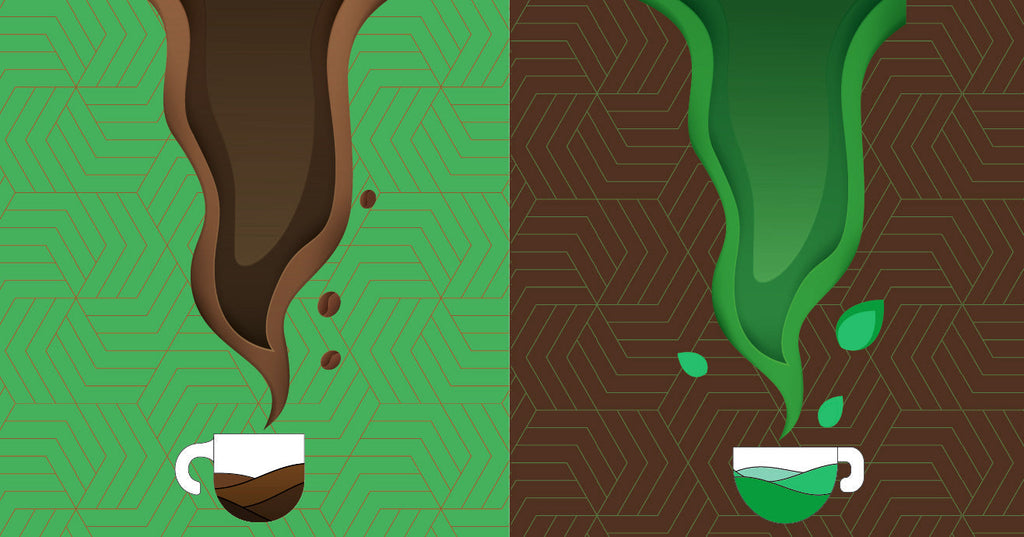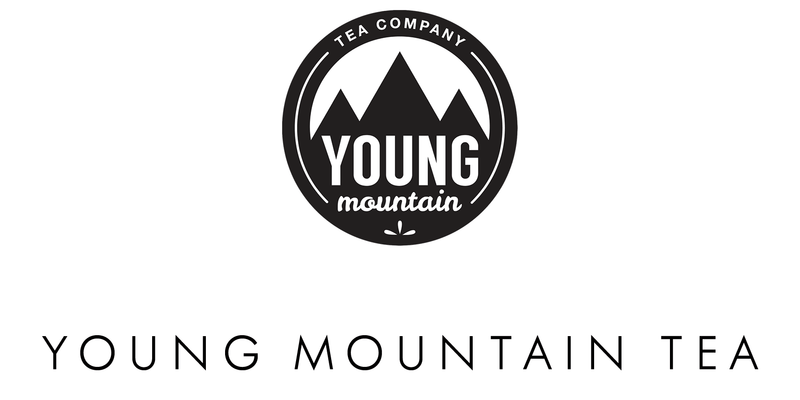Coffee Vs. Tea Beyond Caffeine

I spent the better part of December reading Michael Pollan’s latest book, This Is Your Mind On Plants. It was a fun Solstice, following Pollan as he traced the meteoric rise of caffeine throughout human history. I enjoyed it, but in the end, I felt let down by his passing treatment of tea. So I wanted to provide a more balanced comparison of these two drinks, covering 5 ways they differ, from history to harvesting to health.
Coffee Vs. Tea History
The origin stories of coffee and tea trace back to different parts of the world, and at different times. Tea is older by almost two millennia–the earliest mentions of tea are from 1,000 BCE in southwestern China, while coffee’s first records are from 850 CE in eastern Africa, near modern-day Ethiopia.
From these starting points, both drinks experienced their early boosts in popularity from religion, with students of the cloth relying on them as a source of caffeine to aid in long religious ceremonies. With tea, it was Buddhist monks who brought tea out of China and across Asia. With coffee, it was Sufi priests that popularized the drink in modern-day Yemen.
While the coffee vs. tea history starts in wildly different times and cultures, they both reached Western civilization at roughly the same moment: the 1650s saw the introduction of both tea and coffee to Europe. On a fun side note, in those same few years, chocolate also debuted in Europe, making the 1650s one of the most exciting decades in human history for foodies!
The Botanical Basics of Coffee vs. Tea
Both drinks are made from plants. In the case of tea, there’s only one species, Camellia sinensis, that is used for the most familiar tea types, including black, green, white, oolong, matcha, and puerh. With coffee, there’s one genus, Coffea, and two primary species: Coffea arabica (known as Arabica) and Coffea canephora (known as just Robusta).
The growing conditions of tea and coffee plants are very similar. In fact, Sri Lanka was initially planted with coffee, but after a disease wiped out a large swath of the crop, it was replanted with tea. Coffee and tea do well in tropical, subtropical, or temperate climates with well-drained soil, plenty of sunlight, and heavy rain cycling (think monsoons). When the plants are grown to be harvested, generally the better quality cups of coffee and tea come from higher elevations. In terms of pH, coffee prefers slightly more neutral conditions (6.5-6.8) while tea needs acidic soil (4-6.5).
Both have two commonly cultivated types. Since all tea is one species, there are two types of varietals commonly grown; the high-elevation, low-yielding sinensis varietal is known for sweet, complex flavors while the low-elevation, high-yielding assamica delivers a bold, strong flavor that’s suitable for milk and sugar. Coffee has a similar split, although at the species level: arabica is the high-elevation, smooth and sweet species, while the low-elevation canephora (aka robusta) is high-yield, larger leaf with a stronger more bitter taste.
So from a botanical perspective, the analogy that sinensis is to assamica as arabica is to robusta works fairly well. However when it comes to cup quality, the analogy break down. Talking with owners of coffee companies, robusta is firmly low-quality. As one person put it, "That's gas station coffee." In comparison, assamica can produce exceptional, top quality teas. For example, the entire category of puerhs, one of the most complex and expensive styles of tea, is made exclusively from assamica. Another difference is that with tea, the low-elevation assamica is the more commonly grown cultivar, while with coffee, it is the high-elevation arabica varietal that has taken hold globally.
Both plants require patience as well. It takes farmers around 4-7 years from planting to be ready for harvest. And finally, both plants are being dramatically impacted by climate change, with increasing temperature driving the plants into higher elevations and more northern latitudes.
Harvesting Coffee vs. Tea
While the plants themselves are fairly similar, what we humans do to make the drinks from each is quite different. The coffee bean is actually a seed, located in the heart of a fruit called a cherry. With tea, the drink is made from the terminal leaves of the plant. In short, coffee is a seed and tea is a leaf.
The result is that a single tea bush is harvested many times in a year, as often as every seven days in some regions. Most coffee plants are harvested just once annually, or in some regions like Colombia, a maximum of 2-3 times per year.
Coffee vs. Tea Processing
After harvest, the seeds or leaves get processed to become the finished goods that we all know and love so well. The big difference is that all tea processing happens immediately post-harvest, so within 48 hours of being plucked, the leaf is ready to be drunk. In comparison, coffee has several steps that happen immediately after harvest to get the bean ready for export. After the bean is exported, there are two crucial final steps, the iconic roasting and then the familiar grinding. These two final steps are often done in countries where the bean is drunk. From our company’s perspective, this means tea farmers are doing all the value-add, whereas with coffee, a domestic roaster is bringing the coffee to life. In other words, tea importers like us are traders of finished goods, while coffee importers are dealing with semi-processed goods that still require additional treatment.
One other notable difference in processing is that most high-quality coffee is made using a wet style of production, meaning that water is required. In comparison, with tea no water is required in any of the processing. From a mountain farmer’s perspective, where water is often a scarce resource, this has larger infrastructure requirements than might first meet the eye.
Health Benefits of Coffee vs. Tea
Ok, we’ve now followed the journey of each drink from its growing place in the mountains, through its harvest, past the processing, and into the cup. After brewing the well-traveled plant materials, what ends up in the liquid we enjoy? Since each person’s body processes food and drinks differently, any actual discussion of the health benefits of coffee vs. tea requires degrees that I certainly don't have. So instead, here’s what’s inside each cup:
Caffeine: The stimulant that Pollan credits with much of humanity’s development! While caffeine content varies depending on how each beverage is made, the average cup of coffee has around twice as much caffeine as tea. CAVEAT ALERT! There are tons of complexities influencing the amount of caffeine in tea!
Antioxidants: The wonderful compounds that neutralize free radicals. Free radicals are unstable compounds that can harm our cells if they build up in our systems. Punchline: there are significantly more antioxidants in tea than in coffee. In fact, tea is jam-packed with polyphenols, those compounds rich in antioxidants, more so than even red wine.
L-theanine: An incredible amino acid that crosses the blood-brain barrier and triggers psychoactive effects. L-theanine is correlated with the production of alpha waves, which our minds make when we’re in a calm, relaxed state. And here’s the ringer: L-theanine is only in tea, and not in coffee. In fact, the only known natural sources of L-theanine are tea leaves and a few mushrooms. And it’s the unique combination of L-theanine, caffeine, and antioxidants that make tea special.
And here’s my personal opinion: Tea elevates health in ways that aren't fully described by Western science, but potent just the same. Chinese culture refers to this as a circular life force, or as qi. For me, it’s the magic. There's a uniquely clean energy that a good cup of tea provides that leaves the mind sparkling.
Productivity vs. Transcendence
In the end, we’re just talking about letting some plant material rest in hot water, then drinking the liquid that results. Which is better or worse is, in my view, a moot point. I liked Michael Pollan’s way of summarizing how both have important roles to play; he says that coffee is a tool for productivity, while tea is a vehicle for transcendence. They fuel different types of energy, both necessary, and both delightful.
Want to learn more about tea’s history and caffeine?
You might also enjoy:
Blog Author:

Raj Vable, Founder
He has been confounded by the leaf since his first transcendental encounter with white tea in 2010. Three years later, he started Young Mountain Tea to bridge his budding tea obsession with his interest in traveling in the mountains and previous experience creating job opportunities in rural India. He revels in working across cultures and can be regularly found trying to get the rest of the team on board with another outlandish tea project. His favorite teas remain white, and he’s always searching for the next cup of magic.







Comments on this post (5)
Great Blog. Coffee and tea both contain caffeine, a stimulant that can make you feel awake and energized. Best wishes to you.
— Halmari Tea
Raj, that was a wonderful summary comparing tea and coffee, and a delightful read. I’m amazed to learn that both beverages entered the timeline of Western Civilization at nearly the same time. Thanks for bringing this overview to us, which gives me a better appreciation for my consumption and enjoyment of tea.
— Jim Au
Excellent, informative post! I’m sharing it with all my friends. Thanks for this.
— Ken
Very nice summary. Lots of good information about tea and coffee. I learned a lot. We Thanks!
— Pushpa
Absolutely excellent summary of benefits of tea. Excellent because it is very readable, to the point and yet gracious toward Pollan and coffee. Thank you Raj!
— Tim Draper